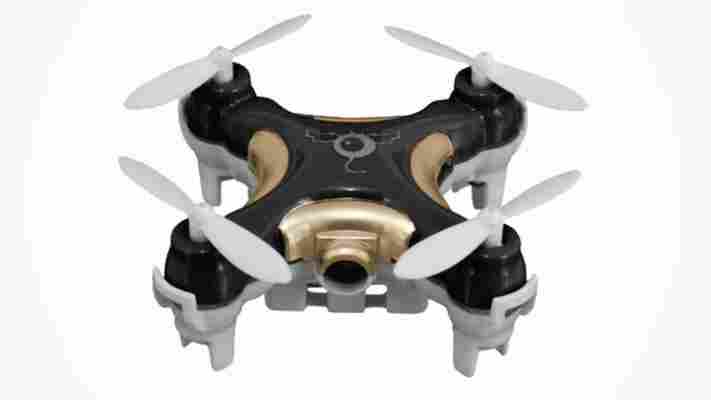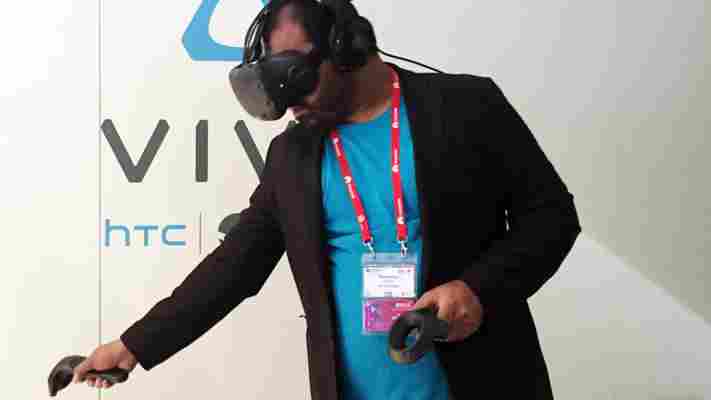Blue’s Lola headphones are a little bit bizarre and a lot brilliant
Last year, long-standing studio audio equipment manufacturer Blue put its first set of headphones up for sale , and now a smaller, lighter version of the cans are available to buy.

With an asking price of $250, the Lola are in direct competition with the more fashion-oriented Beats range, and not all that far away from the more premium Bose and B&O options.
It’s worth noting that those other brands include wireless options, where the Lola is wired-only.
Design and hardware
The Blue Lola look an awful lot like the ‘Mo-Fi’ headphones that arrived at the end of 2014.
What that means is you get a similar multi-jointed chassis and ear-shaped cups that sit over your ears, though somewhat lighter and better balanced than the first generation. It does lose the boost capacities of the Mo-Fi’s as a result, however.
Nonetheless, they pack the same custom, fibre-reinforced drivers to improve the sound of the source material – particularly useful if you’re using them with a mobile or tablet.
The company says the multi-jointed gimbal arrangement now offers more flexibility and is more comfortable for longer sessions.
They’re still extendable downwards so you can wear them around your neck too when not in use. Wearing them like this, as with the Mo-Fi, is really not comfortable at all.
The Lola are lighter (though not ‘light’ at 397 grams) and having used them day-in, day-out for a few weeks, it’s not really occurred to me that they’ve become uncomfortable at any time. That includes some pretty long sessions.
However, I’ve rarely worn or taken them in public without someone looking at me weirdly, or making a comment; they weren’t generally flattering comments.
From what I can garner at a distance, the most frequently mouthed word is ‘why’. Because some people want their headphones to look different? Because Blue Mics believes the design allows for the most flexibility and superior sound?
Whatever the reason you choose to go with, the ‘different’ look doesn’t make Lola’s design a bad thing by default.
Indeed, the slightly oversize earcups ensure a tight fit over your ears and provide a larger chassis, which creates a better, rounder sound.
When worn, the design means they never seem to look like they sit flat on your head. It probably won’t ever bother you though, unless you glance in a mirror or get bored of peoples’ slightly confused glances.
In the box, you get two different length cables and a carrying pouch. So clearly, they’re intended to be taken places. Perhaps just not worn on the way there.
Sound
Let’s be honest, there’s a good chance that if you’re even half-considering the Lola for your next set of cans, you’re probably not putting portability at the top of your ‘must-haves’ list.
Who cares what they look like then, right? You’ll probably be using them mostly at home indoors or in the office, and are you really going to base your headphones on the approval of your co-workers? Exactly.
This is where they really shine through, and it’s where it counts: they sound great.
The bass has a solid, reassuring kick and the mids and treble are crisp and clear. None of the sound comes across as ‘muddied’ at all, and that remains the case whatever you’re listening to. I tested them with everything from drum and bass and dubstep through pop and rock to classical music.
At the top-end, they’re not overly harsh either, which can sometimes be a problem.
They really aren’t going to disappoint based on sound quality, and even cranked up to max, it’s a clean and distinct sound profile led by the 50mm custom drivers.
A dedicated audiophile isn’t going to be satisfied with that description, but that’s not me – and there’s a good chance it’s not you either.
What most people want is to know that the headphones they’re spending hundreds of dollars on will put a big smile on their face, and these ones should.
There’s a ‘but’ coming isn’t there?
There is indeed.
Blue Mic’s Lola provide a great sound, truly, but I’d never spend my money on them.
Like many people, I don’t have the budget to spend on multiple sets of headphones for different situations, and I just put the convenience of being able to throw on something like the Tracks Air far-and-above ‘ultimate’ sound quality.
It’s a bit like having a really fancy car you only use two weekends of the year, versus your everyday runaround – it’d be nice to have both, sure, but that’s just not very practical for most. Good as the Lolas are, they’re definitively ‘low-tech’ in comparison to wireless Bluetooth headphones that let you set your own EQ, and still involve getting tangled up in wires or routing it down through your clothes to wander around.
Add in that they’re generally just quite large and ungainly and that pretty much does it for me.
If, however, you’re looking for a set of headphones you can plug into your computer and pretty much leave there, then you could do a lot, lot worse than Blue Mic’s Lola.
And if you like the distinct design, then that’s even better.
The world’s smallest camera drone + 2GB Micro SD card: $34.99 on TNW Deals
Meet your new favorite flying toy! The Cheerson CX-10C Nano Drone with Camera + 2GB Micro SD Card is a tiny quadcopter is small enough to rest on the tip of your finger, and can easily maneuver through small spaces with acrobatic finesse while recording crystal-clear video and photography.

It’s tons of fun for beginners and drone enthusiasts alike, and for a limited time TNW readers can pick one up for just $34.99 .
The Cheerson CX-10C Nano offers a gentle learning curve, so even if you’ve never flown a drone before you’ll be stunt-flying in no time – and getting great footage to transfer from your 2GB microSD card. Users can easily control the drone even in the tightest spaces via side flight, hover, flip and hand launch capabilities. You can even give your friends some UFO-speculation excitement at night, thanks to its built-in LED lights.
For such a tiny device, the Cheerson CX-10C Nano Drone packs a huge amount of fun. Don’t miss out on this limited time offer – grab yours today for $34.99 plus free shipping.
➤ Get this deal
HTC Vive hands-on: This is the future of gaming
One of the reasons I was excited to attend Mobile World Congress in Barcelona this year was to try out HTC’s Vive VR headset in person. After spending an hour with it, I’m happy to report that the Vive lives up to the hype and then some.

The $799 Vive kit includes a headset tethered with numerous cables, two wireless controllers and two motion tracking base stations that you’ll need to set up in your room.
The headset is comfortable enough for extended gaming sessions and I didn’t feel any sort of motion sickness during my demo. I also liked how the controller design evenly distributed weight across the top and handles so they were easy to grip and use.
Unlike Google Cardboard, the Samsung Gear VR and LG’s 360 VR , this headset connects to a Windows PC and requires considerable firepower to offer a decent experience. HTC recommends a computer with at least a $380 Nvidia GeForce 970 graphics card, so you can expect to spend another $1,000 on your desktop for VR gaming.
In addition, you’ll need a few square feet of space in which to move around while playing and mount the motion-tracking base stations above eye level on opposite walls.
That sounds like a lot of money and effort to improve your gaming experience — but it’s not like you can replicate the rush you get with content on the Vive for any less.
What about mobile VR? Well, the Vive has significantly larger lenses and a pair of screens with a combined resolution of 2160 x 1200 pixels that make for a 110-degree field of view (FOV). Cardboard headsets typically offer a 100-degree FOV, which doesn’t sound like a lot less, but the Vive’s taller viewable area makes a huge difference.
It’s also a tad more cumbersome than compact VR headsets, but HTC has a couple of neat tricks up its sleeve to make the Vive less of a pain to use.
Double-tap a button on the controller to engage the front camera and see what’s around you without taking off the Vive. You can also receive call notifications from your iOS or Android phone and quickly reply to messages by choosing from a bunch of preset responses.
Add in smoother and sharper graphics and the ability to interact with multiple buttons and by physically moving and you’ve got yourself a recipe for incredibly immersive VR experiences.
There’s also the Oculus Rift to consider, and you can get it for $200 less than the Vive and a month earlier too. But at that price, it comes with an Xbox One controller. If you want the company’s Touch controllers , you’ll have to wait until the second half of this year for them.
The first piece of content that came into view during my demo was Wevr Labs’ ‘theBlu: Encounter’. I was able to move around the deck of a sunken ship and see and reach out to touch fast-moving fish all around me.
When a massive blue whale swum slowly in front of me, I literally took a few steps back to dodge its tail, completely forgetting that none of what I was seeing was real.
There were a bunch of other cool demos, including Job Simulator, in which I completed basic tasks like printing photos, answering the phone and chugging coffee in an office.
An app from Google called Tilt Brush let me paint in space with a range of animated materials like light beams and fire — one controller served as a digital palette with colors and tools and the other as a brush.
There was also a shooter game in which I had to dodge enemy fire while aboard a spaceship. My initial loadout included laser guns in both hands, but I could reach behind my back to switch one for a shield and defend myself.
It introduced a new level of flexibility that you don’t usually get with traditional desktop games. You could avoid enemies in a variety of ways instead of being restricted to using shields or ducking, and you can hold your gun sideways while you shoot, as ill-advised as that may be in real life.
A puzzle title called Water Bears VR had me walk around elaborate arrangements of pipes and reconfigure them so they’d pour colored liquids on stange little creatures to free them from bubbles.
It felt far more immersive than desktop games because it required me to move around and manipulate objects carefully using the handheld controllers. If you’ve ever seen the 90s hit puzzle game show The Crystal Maze, you’ll know what this feels like.
Between the high-end PC, the pricey headset and the space you need to set up motion trackers and play, HTC is asking a lot of people who want to enjoy VR in all its glory — but if you can afford it all, you can rest assured that it’ll absolutely blow you away.
The Vive goes on sale on February 29 and will ship in April.
➤ HTC Vive
